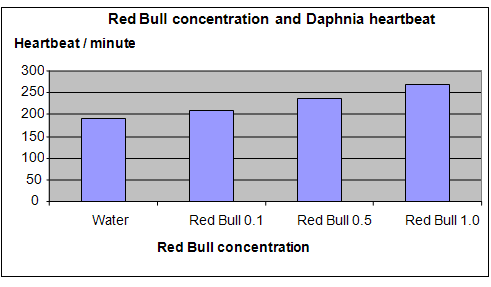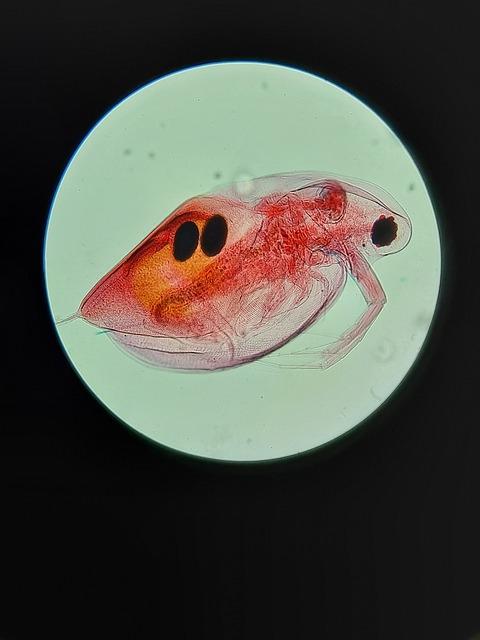| Complexity level: | 7 |
| Project cost ($): | 60 |
| Time required: | 1 hour to prepare, 1 day for experiment |
| Material availability: | Easily found. You will need access to a lake or river to obtain the daphnia required for this experiment |
| Safety concerns: | Handle all laboratory equipment carefully, wearing safety gear/gloves. |
Hypothesis
Red Bull increases the heartbeat rate of Daphnia.
Overview
Red Bull
Red Bull is a very popular energy drink that is consumed all across the world. It is believed that the ingredients that are used to manufacture this drink were taken from a popular Thai energy drink called "Krating Daeng". Some of the ingredients found in this drink apparently include taurine, caffeine, sucrose, glucose, vitamin B, glucuronolactone and phenylalanine. (source: http://en.wikipedia.org/wiki/Red_Bull)
Red Bull manufacturers claim that the energy drink can help to increase an individual’s performance, concentration, reaction time, vigilance and also improve their emotional condition.
Daphnia
Daphnia are tiny aquatic crustaceans also known as "water fleas". They are normally about 0.2 mm to 5.0 mm in length. They normally live in swamps, lakes, streams, rivers and ponds. Their translucent bodies make them suitable for science experiments. The Daphnia’s heartbeat can be directly observed and counted under a microscope.
Scientific Terms
Materials
The materials required for this science project:
- 40 daphnia
- 4 beakers
- 3 cans of Red Bull energy drink
- A microscope
- 4 glass slides
- 1 measurement cylinder
- 1 stopwatch
- 400ml distilled water
- 1 eyedropper
- An assistant
Procedure
1. For this experiment, the independent variable is the concentration of Red Bull solution used. The dependent variable is the number of heartbeats per minute of the daphnia. This is determined by viewing the Daphnia under a microscope and counting the number of heartbeats. The constants (control variables) are the room temperature, the amount of water used and the concentration of the solutions.
2. The first beaker is labeled "water" and filled with 100ml water. The remaining three beakers are labeled and prepared as explained in the table below:
Label Contents of the beaker
· Water 100ml water
· Red Bull 0.1 90ml water mixed with 10ml of Red Bull
· Red Bull 0.5 50ml water mixed with 50ml of Red Bull
· Red Bull 1.0 100ml of Red Bull
3. The daphnia are separated into 4 groups of 10 Daphnia each. Each group of 10 Daphnia is then placed on the 4 slides.
4. The testing is started by placing 3 drops of water on the 1st slide. Wait 15 minutes and then place the slide on the microscope. The number of heartbeats for each of the 10 Daphnia in the slide is counted one at a time while the assistant keeps time. The heartbeats per minute for the 10 Daphnia are totaled and divided by 10 to obtain the average heartbeat. The results are recorded in the table given below.
5. On the remaining 3 slides, 3 drops of the solution marked Red Bull 0.1, Red Bull 0.5 and Red Bull 1.0 are added to each slide. The number of heartbeats for each Daphnia is counted as explained in procedure 4. The average heartbeat is calculated and recorded in the table given below.

Results
The results showed that increasing the concentration of the Red Bull energy drink also increased the heartbeat per minute of the Daphnia in the solution.
|
Daphnia heartbeat per minute in Red Bull solution |
||||
|
Water |
Red Bull 0.1 |
Red Bull 0.5 |
Red Bull 1.0 |
|
|
Heartbeat per minute |
190 |
209 |
235 |
268 |
The graph below represents the results of our science project experiment:

Conclusion
The hypothesis that Red Bull drink increases the heart beat of Daphnia is proven to be true.
The invigorating experience and feeling gained after drinking a bottle of Red Bull is probably due to the caffeine in the drink. The actual level of caffeine in the Red Bull drink may not be the same in different countries due to different regulatory controls and laws of each country.
Also consider
The experiment can also be done by using other energy drinks like Monster.
Try to repeat the experiment by adjusting the room temperature.
References
Red Bull - http://en.wikipedia.org/wiki/Red_Bull
Daphnia - http://en.wikipedia.org/wiki/Daphnia

